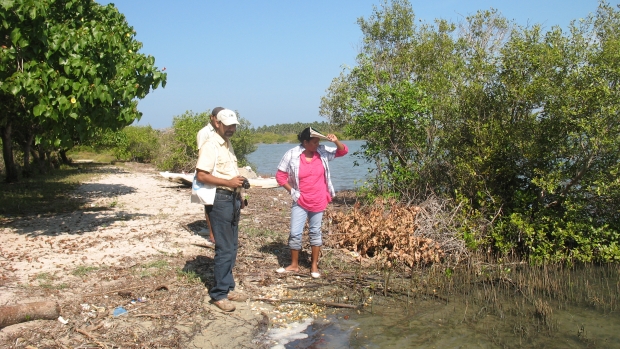Grants :: Small Grant Facilities :: Studying carbon sequestration in mangroves
Studying carbon sequestration in mangroves

Studying Carbon sequestration in mangroves , Kalpitiya © Kumudini Ekaratne, IUCN, 2012
Objectives
- Simulate different scenarios of mangrove restoration model for Puttalam lagoon taking into account land tenure, ownership and biodiversity significance.
- Calculate the above and below ground biomass production for different mangrove combinations using appropriate model.
- Quantify the carbon loading for above scenarios.
- Identify the factors that determine the willingness to participate and the main incentives expected by selected communities in Puttalam lagoon
Background
Disturbed mangrove in Puttalam lagoon has created many problems such as loss of habitat, threatening land use pattern of the lagoon, degradation of biodiversity, etc. expansion of shrimp farm and salt pans has become a major reason for habitat destruction. One hidden objective of mangrove restoration is the carbon sequestration. Therefore this project aims to calculate the potential biomass production and likely amount of carbon that can be sequestrated with mangrove rehabilitation in Puttalam lagoon. This project will also help to fill the research gap in quantifying the benefits of mangrove restoration.
Interventions:
- Validation of current land use and extent of mangroves by using existing data and maps.
- Identify the potential areas for restoration and conduct a feasibility study for land restoration through community participation by surveying willingness to participate.
- Model different scenarios and calculate the carbon sequestration in 1.5 year old Rhizophora apiculata plants.
Target beneficiaries
Researchers, community.
Outputs
- Maps indicating different mangrove restoration scenarios for Puttalam lagoon
- Key points that needs to be addressed when promoting communities to participate
- Biomass accumulation under different planting regimes and carbon sequestration values in identified areas
Accomplishments and challenges
The result from the field evaluation had shown that the highest percentage of carbon was in the stilt roots, while the lowest carbon percentage was in leaves and branches. Among the other findings were as follows:-
- The dry weight ratio of above ground parts was 80.6% compared to 19.4% for below ground parts.
- Despite of a high diversity races and religious groups there was consensus that replanting up to 60% was important.
- There was a difference in user characteristics of mangroves between males and females.
- Around 60% of the population agreed that mangroves were important in reducing global climate change.
- In relation to experiences in replanting, the majority of people (nearly 75%) had no experience.
Contributions to cross-cutting themes
Around 60% of the population interviewed agreed that mangroves were important in reducing global climate change.
Lessons Learned
The tradeoff between research and uprooting of plants for analysis should be considered . Uprooting plants for research itself is a problem in the Puttalam Lagoon. Hence, it has been proposed that future carbon sequestration studies should involve only non-destructive methods.
Project Facts
Country
Location
Puttalam
Topic
Duration
5th Jan 2011 to 30th Apr 2012
MFF Grant Amount
LKR 425,000.000
Implementing Partner
Dr Sevvandy Jayakody
Department of Aqauculture and FisheriesFaculty of Livestock, Fisheries and NutritionWayamba University of Sri LankaMakandura Gonawila Sri Lanka email: Sevvandi_jayakody@yahoo.com
"This is good study. We would like to know the results" Community member